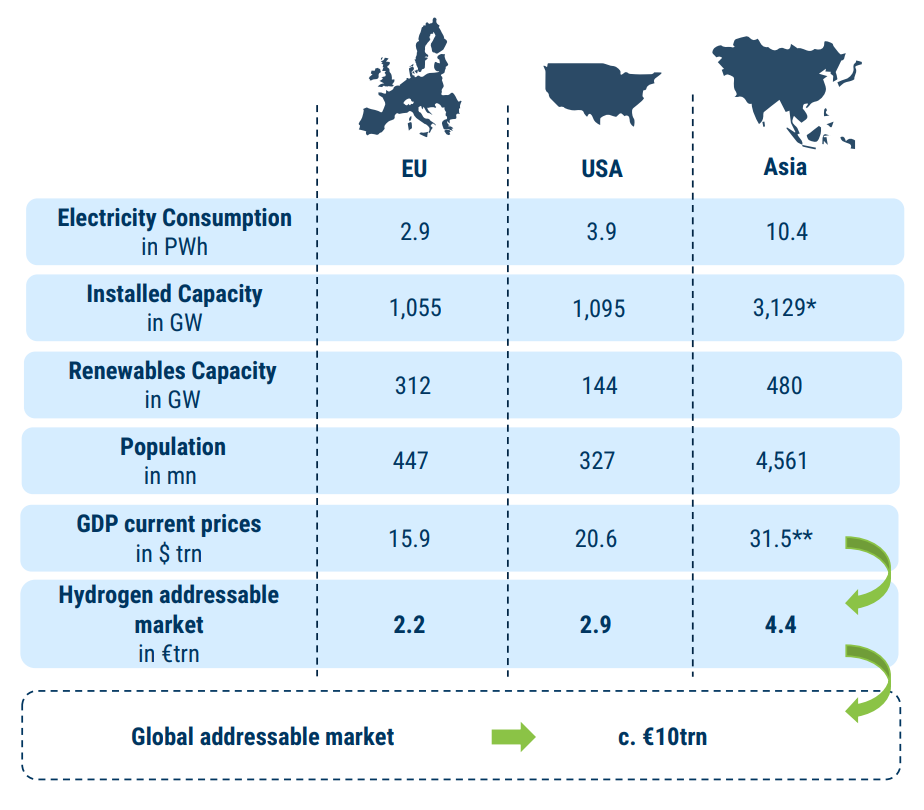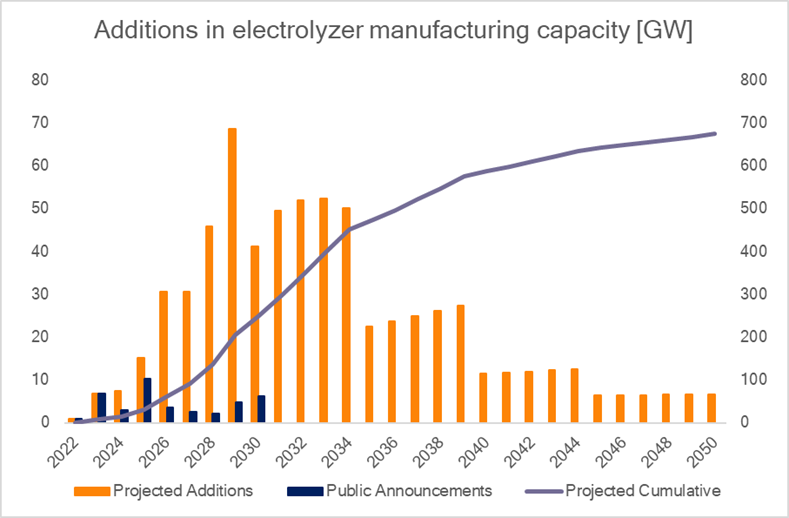Future Market Snapshot
As the energy consumpation is taking at gargantual volume in current utility sector in
the world, e-Hydrogen has a huge potential that would see creating a mammoth 10 trillion euro market
globally. Let's see the figures below.
10
trillion
Global Market by 2050 (euro)
2trillion
European Market by 2050 (euro)
65%
share of Cost for H2 production from Electricity (EU)
650fold
Increase of EU electrolyser market (by 2030E)
8000 fold
Increase of EU electrolyser market (by 2050E)
3fold
Increase in EU renewables annual additions (35GW to 90GW)
100%
Increase in EU power demand from clean H2 (2020-50E)
1.5euro
stimated solar to clean H2 cost by Iberia Airline (per kg)
Current H2 Market
Estimated costs of hydrogen per kilogram in variety of scenarios are
follows
| Source |
Cost per kg H2 |
| Natural Gas
[ Produced via steam reforming at fuelling station] |
$4 – $5 |
| Natural Gas
[ Produced via steam reforming off-site and delivered by truck] |
$6 – $8 |
| Wind
[via Electrolysis] |
$8 – $10 |
| Neucler
[via Electrolysis] |
$7.5 – $9.5 |
| Solar
[via Electrolysis] |
$10 - $12 |
| Nuclear
[ via Thermochemical Cycles – assuming the technology works on a large
scale] |
$6.5 - $8.5 |
| Solar
[ via Thermochemical Cycles – assuming the technology works on a large
scale] |
$7.5 – $9.5 |
At present per kg H2 cost $4 to $12, and per gallon Gasoline
cost $1.60
to
$4.80.
The major future markets for hydrogen depend primarily upon 4 factors
- The future cost of hydrogen.
- The rate of advances of various technologies that use hydrogen.
- Potential long-term restrictions on greenhouse gases.
- The cost of competing energy systems.
Eleven potential major markets for hydrogen are considered, several of which
represent alternative markets. Each market is characterized by several
parameters that impact the choices of preferred production technologies as
illustrated in Table 2 and defined below
| Market |
Product |
Oxygen
Use |
Heat
Use |
Existing
Market
|
Site
Specific |
User
Size |
Steady
State |
Storage &
Distribution |
| Refineries
|
Liquid Fuel
|
No
|
Maybe
|
Yes
|
No
|
Large
|
Yes
|
No |
| Heavy Oil and Tar
|
Liquid Fuel
|
Maybe
|
Yes
|
Yes
|
Yes
|
Large
|
Yes
|
No |
| Coal Liquefaction
|
Liquid Fuel
|
Yes
|
Yes
|
Yes
|
Yes
|
Large
|
Yes
|
No |
| Atmospheric Liquid Fuels |
Liquid Fuel |
No |
Maybe |
No |
No |
Large |
Yes |
No |
| Biomass Fuel |
Liquid Fuel |
No |
Maybe |
No |
Yes |
Medium |
Maybe |
Yes |
| CarboDioxide Recycle Fuel |
Liquid Fuel |
No |
No |
No |
Yes |
Medium |
Yes |
Distribution |
| Chemical |
Chemicals |
No |
Maybe |
Yes |
No |
Variable |
Yes |
No |
| Peak Electricity Nuclear System |
Peak Electricity |
Yes |
Maybe |
No |
Yes |
Large |
Yes |
Storage |
| Iron |
Iron |
No |
Yes |
Yes |
Yes |
Large |
Yes |
No |
| Aircraft |
H2 Fuel |
No |
No |
No |
Yes |
Medium |
No |
Yes |
| Hydrogen Direct Transportation |
H2 Fuel |
No |
No |
No |
Yes |
Small |
No |
Yes |
At present per kg H2 cost $4 to $12, and per gallon
Gasoline
cost $1.60
to
$4.80.
Application of clean H2 | Major H2 Markets
The biggest application of liquid H2 is in aircraft and vehicle industries.
- Commercial Jets: Commercial aircraft can be fuelled with liquid
hydrogen.
According
to Airbus Deutschland GmbH, they are working on a project named CRYOPLANE, which
aimed to build hydrogen-fuelled aircraft.
- Hypersonic Jets: Hypersonic aircraft require liquid-hydrogen fuel.
The air
velocity through a ram jet requires a fuel with a very fast flame temperature and
diffusion rate to ensure combustion within the engine. Hydrogen is the only option.
Liquid hydrogen is also used to provide active cooling to leading aircraft surfaces
to avoid melting.This market depends upon the development of these jets.
-
Electric Aircraft: Aircraft can use electric motors and hydrogen
fuel cells to power
propellers. These systems have potentially very high efficiencies compared with
alternative propulsion systems.
-
Hydrogen Auto and Truck Transport System: Hydrogen
is proposed as the ultimate transport fuel for cars, trucks, and buses. Recent
reports (U.S. National Research Council 2004) describe the various scenarios. This
can be considered the ultimate end state of hydrogen development if the various
technical barriers are eliminated.
ELECTROLYZER MANUFACTURING CAPACITY[GW], GETTING MOMENTUM
- Green hydrogen is projected to be the leading hydrogen production method by 2039.
- Green hydrogen market to reach a $850 billion valuation in 2050,
- 650 GW of electrolyzer manufacturing capacity and expects cumulative sales of $2
trillion.
- renewable hydrogen supply costs would break even at approximately 3.0 €/kg with
natural gas prices at 50 €/MWh (2025 price forecast by the IEA).
- Masdar and Airbus have agreed to support the development of the global sustainable
aviation fuel market development.
- A new wave of power plants with Hydrogen Turbines
- Current EU primary Energy Mix consists of 2% Hydrogen(H2) share and could
reach upto
15% by 2050, an 750% increase.
- Southern Europe could be a major producer/exporter of hydrogen.


